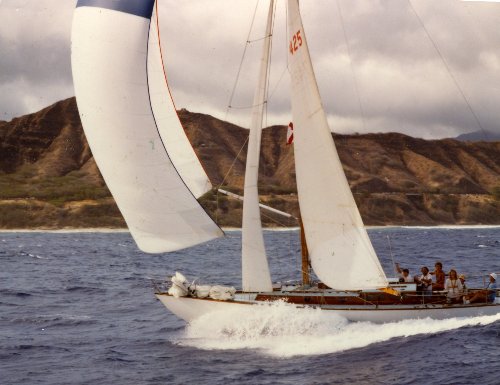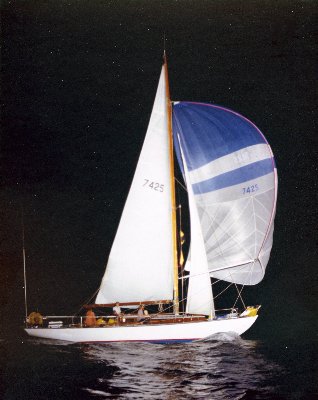My first experience sailing on a PCC was on Selene with "Uncle Ed" Vail for a very windy Santa Barbara Yacht Club Opening Day Race sometime in the 50s. It was blowing 35 knots from the northwest. Only the hardiest and biggest boats went out, Selene, the big schooners Rejoice and Samarang and the yawl Cheerio II. "Uncle Ed" loved the breeze and did not mind heeling. We sailed the windward leg with the working jib and reefed main. The tops of the lifelines and winches were almost always under water and the leeward side of the cockpit awash. We tried to convince "Uncle Ed" that this was not fast, but he was in his element. We were first to the weather mark, so he must have been correct. After a downwind leg and a reach there was a short upwind leg and a run to the finish. As we rounded the last upwind mark and bore off there was a vast sloshing sound from below and as the boat stood up she settled so low in the water you could touch the ocean standing on the cockpit floor. A quick look below confirmed the worst. We were sinking. There was a foot of water over the floorboards below and the water in the cockpit was up to the threshold. The engine was completely under water. We abandoned the race and sailed into the lee of Stearns Wharf pumping and bailing with buckets. We were gaining on the water. No more was coming in. As it turned out, the covers for the winch handle pockets by the grandfather seats had not been put in and they open into the bilge. All of the hard driving sailing was keeping these large holes under water and happily filling up the boat from the ocean. We did not sink but "Uncle Ed" had a serious repair bill.
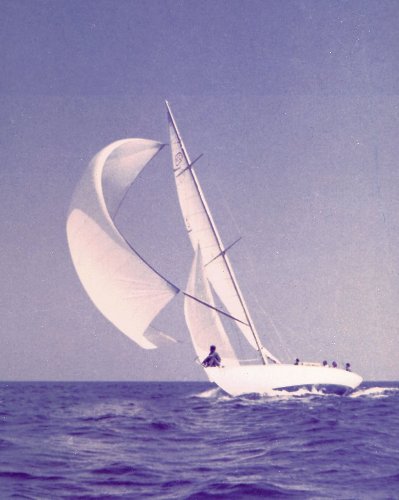
Selene off Santa Barbara in 1962
Photo by Dick Cleveland
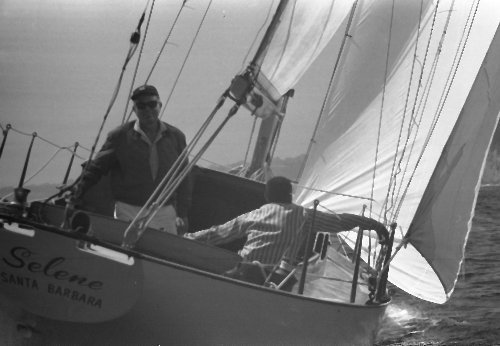
Ray Dawley in Selene
Selene, PCC #3, was originally owned by Edward White who sailed
her in the 1947 Transpac. In the 50s Ed Vail, a principal of Vail Vickers,
which ran cattle on Santa Rosa Island owned her. Ed sold her to my father,
Ray Dawley, in 1960. Subsequently my father sold her to Ken Urton. Ed,
Ray and Ken, lived in Santa Barbara and were members of SBYC.
While Rosemary Jobbins and I were in college and courting, my father sold
our beautiful but very small 6-meter, Mystery, and bought Selene.
The Jobbins with Undine, PCC #25, and the Dawley's with Selene
cruised together and raced fiercely against each other in the early 60s.
I remember the racing as being a bit difficult as Undine was definitely
newer and faster. Her new North sails were far better than Selene's
Watts sails. We called Undine the "rubber band boat",
as there was a big piece of shock cord in the luff of the main and enough
extra material in the luff of the sail that you could take a whole turn
on the roller reefing and not let off the halyard at all. Her 2 oz, 209%
genoa was also a real killer in Santa Barbara's light airs.
Undine, the last PCC, #25, was built for my father-in-law, Dr.
Charles Jobbins in 1959. Dr. Jobbins actively raced and cruised her until
his death in 1964. Undine was the first big boat to use North Sails.
He became a great friend and supporter of Lowell North. In fact, Lowell
was a pallbearer at Dr. Jobbins funeral. Dr. Jobbins was PCC Class Champion
in 1962, 1963 and 1964. My wife Rosemary and I bought Undine in
1967. We raced and cruised her extensively in Southern California. We
were Class Champions in 1968 and 1970. During these years you could generally
count on 8 to 12 boats for the class championships and the SCYA Midwinter
Regatta. One design big boat racing is truly a great experience. For several
years in Santa Barbara in the late 50s and early 60s there would often
be 5 PCCs out for local racing (Gossip, Malaguena, Rascal, Selene
and Undine).
Undine participated in several Lipton Cup Challenges (one race,
all challengers and the defender sail together in a fleet race without
handicap - winner takes all.) in the late 60s and early 70s. . We were
the challenger several times. This is not as glamorous as it sounds. The
deed of gift specified that there could be a 10% difference in the ratings
among the fleet. The club or owner really wanting to challenge would find
someone rating 10% lower than their hottest boat to place the initial
challenge. Then everyone else would jump in as additional challengers.
Therefore, generally the initial challenger was the slowest boat in the
fleet. The real competitors in this time were Cal-32s (not a Jensen Marine
fiberglass Cal boat but the beautiful, wooden 32' LWL 46 footers designed
by Nick Potter), Q boats and 8 meters. These were all faster than a PCC
but we went along with the gag, hoped for a miracle and had a great time.
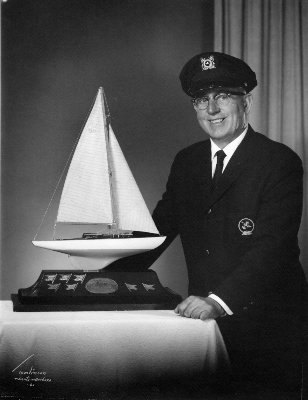
Dr. Jobbins
with the PCC Class Championship Trophy
Photo
by Tomlinson
PCCs were also really heavy on the helm when you were power reaching. If it was blowing over 20 knots a strong, tall person would sit to leeward with both feet on the tiller while the actual driver sat to
weather steering and commanding the strong person to leeward to
push like hell with his feet when real force was needed.
Knowing that a spade rudder would make her a different boat downwind
and that the cockpit volume was too large for the offshore safety requirements,
we took her to Kettenburg's for modification before the trip to Hawaii.
We shortened up the cockpit taking out the beloved "grandfather"
seats and installed a spade with tiller steering. What a difference! You
could steer her in anything with two fingers and even let the helm go
for up to 30 seconds when surfing.
In 1972 we had 18-year-old Peter Schuyler, a crew of youngsters and one
adult, Dr. Ross Howe all from Santa Barbara, sail Undine to Kailua-Kona
on the big island of Hawaii. They had an easy 13-day passage. We then
embarked with our 3 children, ages 2, 5 and 7, along with four of the
passage crew (read crowded) and spent a month cruising Hawaii, Maui, Lanai,
Molokai, Oahu and Kauai. It was a wonderful cruise and believe me it is
the only way to cruise Hawaii - downwind.
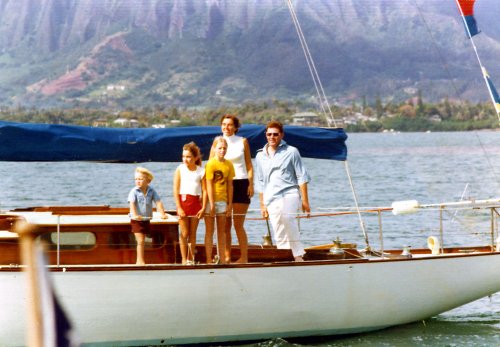
Mike, Lisa, Heidi, Rosemary and Norm Dawley aboard Undine, Kaneohe YC Opening Day 1974
In 1976 the PCC Mickey was lost on the reef off the Hilton Hawaiian Village. Don Anderson, who was fitting out a Columbia 50 bare hull, and I bought the wreck. I got the sails, running and standing rigging. He got the winches, lead and we sold the engine. A sad end for Mickey, but we really did use those sails, especially the 1.5 and 2.2 ounce running spinnakers, in the 1977 Transpac.
Between the 75 and 77 races, being tired of perpetual varnishing and repairing bent genoa track on the cap rail, I removed the cap rail and bulwarks and replaced them with an aluminum extrusion. That got rid of 90+ feet of varnish leaving "just" the mast, boom, spinnaker poles, cabin sides, cockpit seats… you are all familiar with the drill. The mast had to be varnished every 3 months in Hawaii. I remember many beautiful days on the mooring Kaneohe Bay pulling myself up the mast on a 5 part falls, sanding up and varnishing down. Then you would pray that a passing squall did not turn the wet varnish into a moonscape before it dried
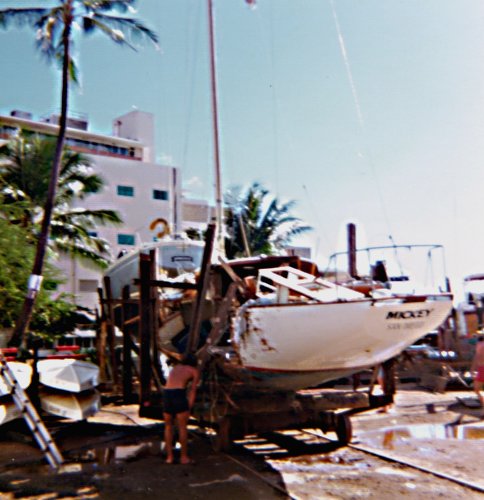
Poor Mickey after spending a night on a coral reef
